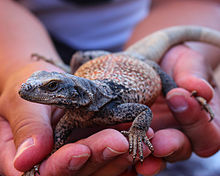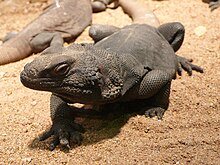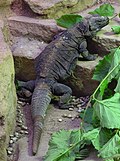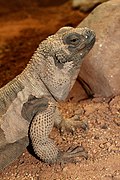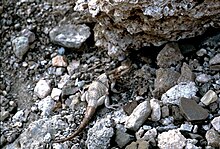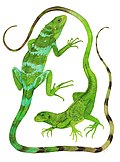
The desert horned lizard is a species of phrynosomatid lizard native to western North America. They are often referred to as "horny toads", although they are not toads, but lizards.
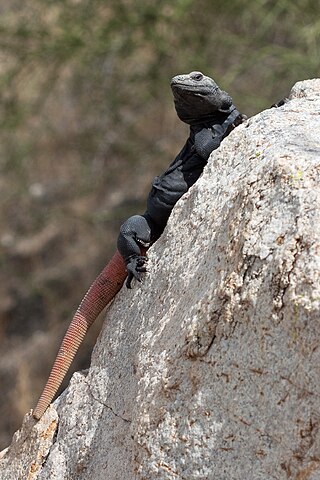
Sauromalus ater, also known as the common chuckwalla or northern chuckwalla, is a species of lizard in the family Iguanidae. It inhabits the Sonoran and Mojave Deserts of the Southwestern United States and northwestern Mexico. Its range extends from eastern California, Utah, and Nevada south to Baja California and Sonora.

Aridoamerica denotes an ecological region spanning Northern Mexico and the Southwestern United States, defined by the presence of the culturally significant staple foodstuff Phaseolus acutifolius, a drought-resistant bean. Its dry, arid climate and geography stand in contrast to the verdant Mesoamerica of present-day central Mexico into Central America to the south and east, and the higher, milder "island" of Oasisamerica to the north. Aridoamerica overlaps with both.
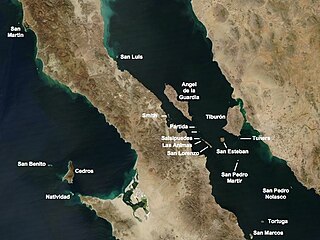
San Esteban Island is a small island in the Gulf of California, Mexico, located to the southwest of Tiburón Island. It is part of the Municipality of Hermosillo in Sonora and has a land area of 39.773 km2, the 15th-largest island in Mexico. It is located in the Gulf of California. It was once inhabited by a group of the Seri people.
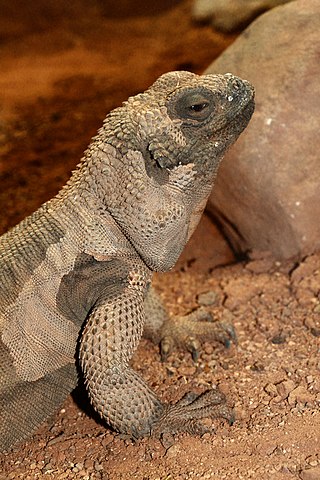
The Angel Island chuckwalla, also known as the spiny chuckwalla, is a species of chuckwalla lizard belonging to the family Iguanidae endemic to Isla Ángel de la Guarda in the Gulf of California. The species was transported to other islands by a tribe of the Seri as a potential food source.

The San Esteban chuckwalla, also known as the piebald chuckwalla or pinto chuckwalla, is a species of chuckwalla belonging to the family Iguanidae endemic to San Esteban Island in the Gulf of California. It is the largest of the five species of chuckwallas, and the most threatened.
Sauromalus slevini, also known as the Monserrat chuckwalla or Slevin's chuckwalla, is a species of chuckwalla belonging to the family Iguanidae. S. slevini is native to three small islands in the Sea of Cortés.

Ctenosaura hemilopha, also known as the Baja California spiny-tailed iguana, is a species of spinytail iguana endemic to Baja California. It is arboreal and primarily herbivorous, although it can be an opportunistic carnivore. Males may grow up to 100 centimeters (39 in) in length, while females are smaller, with a length of up to 70 centimeters (28 in). Five subspecies are currently recognized.
Isla Mitlán, is an island in the Gulf of California, located within Bahía de los Ángeles east of the Baja California Peninsula. It is adjacent to the west coast of Isla Coronado.The island is uninhabited and is part of the Ensenada Municipality.
Isla Flecha, or the Arrow, aka Isla El Borrego, is an island in the Gulf of California, located within Bahía de los Angeles east of the Baja California Peninsula. The island is uninhabited and is part of the Ensenada Municipality.
Isla Granito, is an island in the Gulf of California east of the Baja California Peninsula. The island is uninhabited and is part of the Mexicali Municipality.
Isla Pond, is an island in the Gulf of California east of the Baja California Peninsula. The island is uninhabited and is part of the Mexicali Municipality.
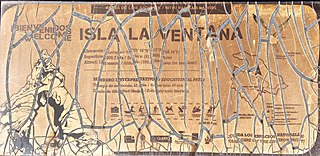
Isla La Ventana, or the Window, is an island in the Gulf of California, located within Bahía de los Ángeles east of the Baja California Peninsula. The island is uninhabited and is part of the Ensenada Municipality.
Isla Mejia is an island in the Gulf of California east of the Baja California Peninsula. The island is uninhabited and is part of the Mexicali Municipality.
Isla Rasa is an island in the Gulf of California east of the Baja California Peninsula. The island is uninhabited and is part of the Mexicali Municipality. The 0.21 sq./mi island has three small ponds and has small shed located in the center of the island.
Isla Roca Lobos is an island in the Gulf of California east of the Baja California Peninsula. The island is uninhabited and is part of San Felipe Municipality.
Isla San Lorenzo Norte is an island in the Gulf of California east of the Baja California Peninsula. The island is uninhabited and is part of the Mexicali Municipality. The much larger Isla San Lorenzo Sur is located immediately southeast of Isla San Lorenzo Norte.
Isla San Lorenzo Sur, is an island in the Gulf of California east of the Baja California Peninsula. The island is uninhabited and is part of the Mexicali Municipality. Isla San Lorenzo Norte is located immediately northwest of Isla San Lorenzo Sur.
Isla Cabeza de Caballo, or Head of the Horse, is an island in the Gulf of California, located within Bahía de los Ángeles east of the Baja California Peninsula. The island is uninhabited and is part of the Ensenada Municipality. There is a lighthouse located on Isla Cabeza de Caballo along the channel into the harbor of Bahía de los Ángeles.
Isla Piojo, or Lice Island, is an island in the Gulf of California, located within Bahía de los Ángeles east of the Baja California Peninsula. The island is uninhabited and is part of the Ensenada Municipality.
